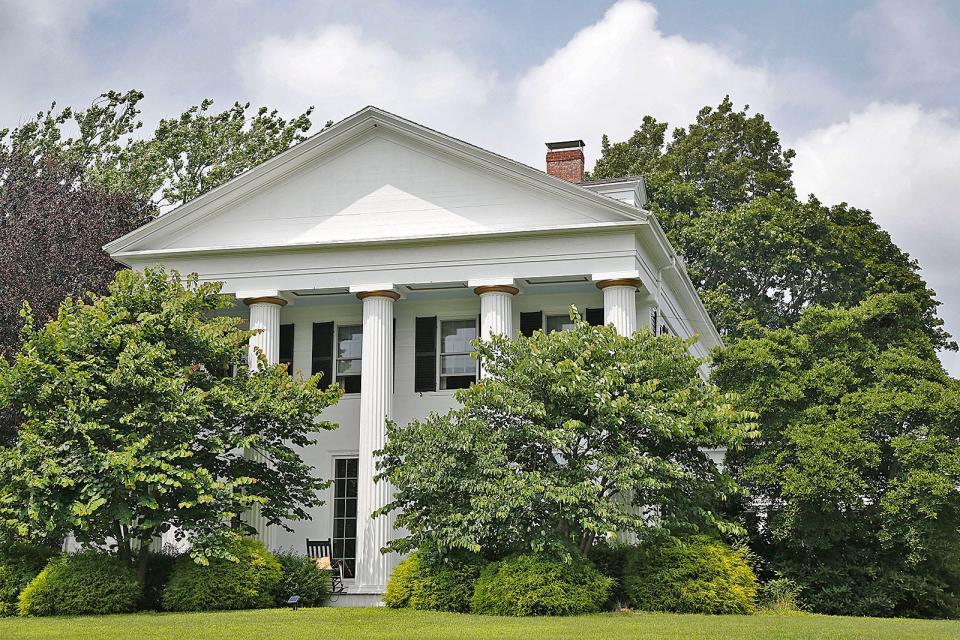A home with history: Braintree's Jechonias Thayer House
- Oops!Something went wrong.Please try again later.
Newport has its mansions, but the South Shore has its own grand historical homes where the public can marvel at the lives of the upper class. Most of these “cottages” were stately homes designed by notable architects. This is part of The Patriot Ledger's summer series "Summer Houses with History."
BRAINTREE − It wasn't in the mountains, and the shore was miles away. But Jechonias Thayer had something else in mind when he built the landmark Greek Revival home on Elm Street as a summer retreat for his wife and his family: proximity to family.
Born in Braintree in 1786 and a Mayflower descendant, Thayer became a shipping merchant in Boston. In his history of Braintree, John Dennehy wrote that Thayer built the house in 1835 "near the 1640 home site of his ancestor Thomas Thayer."
The year 1640 was when Braintree was incorporated as a town.
The blog "Buildings of New England" describes the Jechonias Thayer House as a "high-style, temple-front Greek Revival home in the Doric order. The two-story columns support the colonnade and heavy, pedimented gable."

Jechonias Thayer's father, Solomon Thayer, had lived on the land in an earlier dwelling, "Buildings of New England" says.
A paymaster and a quartermaster in the Massachusetts Volunteer Milita during the War of 1812, Jechonias Thayer and had a grocery business after the war. From 1836 to 1840, he ran Thayer and Co. in New Orleans.
A member of the Massachusetts Society for Promoting Agriculture, Thayer once sent a barrel of corn to former President Thomas Jefferson at his Monticello home in Virginia. Thomas May, who handled the final leg of the shipment, wrote Jefferson that "Mr. Thayer states to us the corn is considered valuable as being very prolific but requires a longer season to mature than that of Massachusetts."
More: 'An escape from Boston': Past and future meet at Bradley Estate in Canton
The letter is held by the National Archives.
Thayer owned the house for more than three decades before it was sold by trustees nine years before his death in 1876. At the time of his death, he was living with his daughter Mary Hollingsworth in a house on Commonwealth Avenue in Boston's then-new Back Bay.
Since then, the Braintree house has gone through more than a dozen owners. One of them was the Boston archdiocese, which used it as a convent for members of the Sisters of Charity of Nazareth, who taught at the now-closed St. Thomas More Elementary School.
More: Bigelow estate evokes memories of Cohasset's 'summer colony' era
"Buildings of New England" says the next owner of the house, Boston iron merchant Edward Reed, used it as a country house. Reed died in 1891.
Leonard F. Norris, a Brockton real estate broker, was the third owner of the house. When he died in 1908, his son F. Edgar Norris inherited the property and renovated it.
Edgar's son, Lowell Ames Norris, was a writer who named the property "Norcrest." "Buildings of New England" said Lowell Norris wrote about the renovated home in many architectural publications.
He also wrote or edited more than 3,000 detective stories, according to his New York Times obituary. His son, Curt Norris, had a long-running column on New England mysteries in The Patriot Ledger. Their papers are housed at Brown University.
More: Camp Kiwanee: A 'rustic retreat' for a prominent Boston family
The house is still a private home, last sold in 2020 for $1.6 million, according to Zillow.
The real estate listing described it as a five-bedroom, four-bathroom, more than 6,000-square-foot home that had "extensive renovations" in between 2011 and 2019, "beautifully recapturing its early 18th-century grandeur." It has an in-ground pool and original walnut pegged oak floors. The listing also said it has "potential for a second buildable lot."
Reach Fred Hanson at fhanson@patriotledger.com.
More: Whatever happened to the Hall Estate in Hull?
Thanks to our subscribers, who help make this coverage possible. If you are not a subscriber, please consider supporting quality local journalism with a Patriot Ledger subscription. Here is our latest offer.
This article originally appeared on The Patriot Ledger: 19th-century house on Braintree's Elm Street has long history

